The Condor Galaxy is a large barred spiral galaxy located 212 million light-years away in the southern constellation Pavo (the Peacock). It is listed as NGC 6872 in the New General Catalogue. The galaxy has an apparent magnitude of 10.69 and is in the process of interacting with its smaller neighbour, the lenticular galaxy IC 4970.
The Condor Galaxy stretches over 522,000 light-years across – more than five times the size of the Milky Way – and is one of the largest known spiral galaxies. It has an isophotal diameter of more than 717,000 light-years. The galaxy’s stellar bar has a radius of about 26,000 light-years, which is around twice the average length found in barred spiral galaxies. The giant galaxy contains anywhere between 500 billion to 2 trillion stars.
As a result of its interaction with IC 4970, NGC 6872 has the distinctive shape of the integral sign. The elongated shape was slowly produced after the smaller galaxy made its closest approach around 130 million years ago. Simulations have shown that IC 4970 approached the Condor Galaxy almost along the plane of its spiral disk. The interaction distorted the larger galaxy’s shape and stretched out its spiral arms.
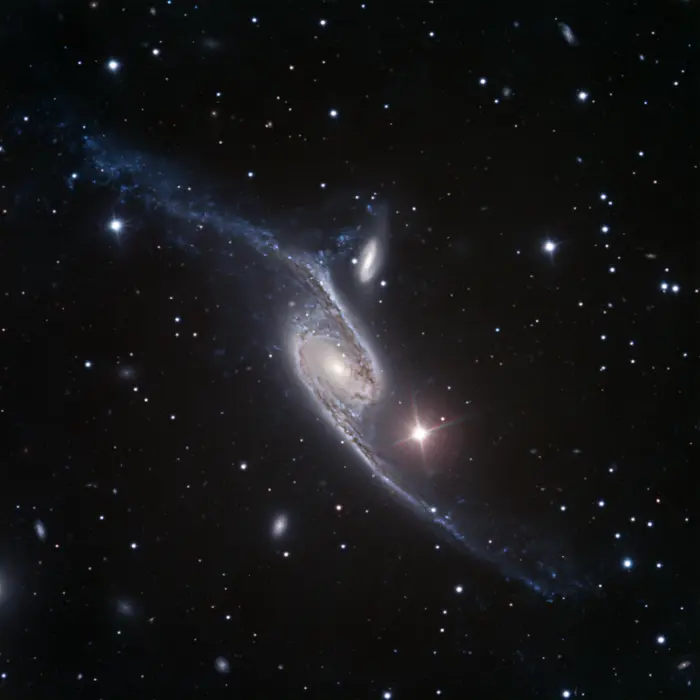
Condor Galaxy (NGC 6872), image credit: ESO/VLT, Judy Schmidt (CC BY 4.0)
The elongated arms contain active regions of star formation. While the galaxy’s central region and bar show little evidence of new stars forming, the rate of starburst activity increases with the distance from the core. The spiral arms are dotted with young star clusters with estimated ages between a million years and 100 million years.
The northeastern arm contains the most active region of star formation, where stellar flux is about a thousand times higher than in the galaxy’s core. In this region, new stars form at twice the rate of the southwestern spiral arm and five times the rate of the spiral arm sections closer to the core.
Observations with NASA’s Galaxy Evolution Explorer (GALEX) and NASA’s Spitzer Space Telescope in 2013 in ultraviolet and infrared wavelengths revealed that star formation in the northern tail was triggered beginning 130,000 light-years ago from the nucleus of NGC 6872 by the interaction between the two galaxies. The southwestern arm shows the same pattern.
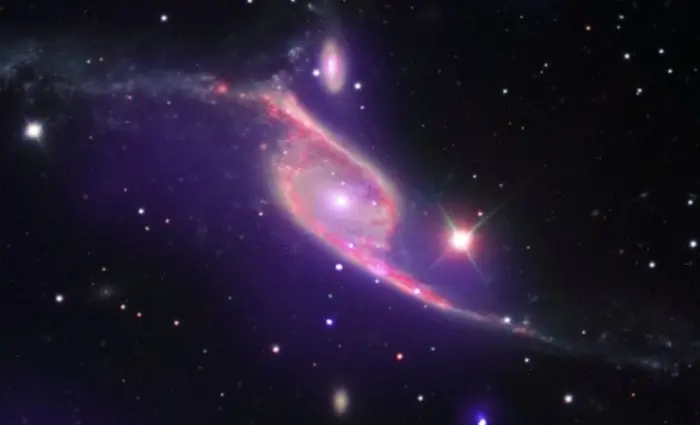
This composite image of data from three different telescopes shows an ongoing collision between two galaxies, NGC 6872 and IC 4970. X-ray data from NASA’s Chandra X-ray Observatory is shown in purple, while Spitzer Space Telescope’s infrared data is red and optical data from ESO’s Very Large Telescope (VLT) is colored red, green and blue. Astronomers think that supermassive black holes exist at the center of most galaxies. Not only do the galaxies and black holes seem to co-exist, they are apparently inextricably linked in their evolution. To better understand this symbiotic relationship, scientists have turned to rapidly growing black holes — so-called active galactic nucleus (AGN) — to study how they are affected by their galactic environments. The latest data from Chandra and Spitzer show that IC 4970, the small galaxy at the top of the image, contains an AGN, but one that is heavily cocooned in gas and dust. This means in optical light telescopes, like the VLT, there is little to see. X-rays and infrared light, however, can peek through this veil of material and reveal the light show that is generated as material heats up before falling onto the black hole (seen as a bright point-like source). Despite this obscuring gas and dust around IC 4970, the Chandra data suggest that there is not enough hot gas in IC 4970 to fuel the growth of the AGN. Where, then, does the food supply for this black hole come from? The answer lies with its partner galaxy, NGC 6872. These two galaxies are in the process of undergoing a collision, and the gravitational attraction from IC 4970 has likely pulled over some of NGC 6872’s deep reservoir of cold gas (seen prominently in the Spitzer data), providing a new fuel supply to power the giant black hole. Image credit – X-ray: NASA/CXC/SAO/M.Machacek; Optical: ESO/VLT; Infrared: NASA/JPL/Caltech (CC BY 4.0)
Ultraviolet observations have revealed a tidal dwarf galaxy candidate near the larger Condor. The object appears at the far end of the northeastern spiral arm of NGC 6872 and can only be detected in the ultraviolet band. Astronomers believe that the object contains stars less than 200 million years old, which roughly corresponds to the timeframe of the collision.
Observations with the XMM-Newton space telescope in 2004 detected a trail of enhanced X-ray emission between the Condor Galaxy and the nearby elliptical galaxy NGC 6876. With an estimated length of 90 kiloparsecs (290,000 – 330,000 light-years), it is one of the longest X-ray trails ever observed.
The Condor Galaxy is moving away from NGC 6876 at 849 ± 28 km/s in the same path as the X-ray trail, indicating that the two galaxies are linked. If the two galaxies had interacted in the past, the elliptical galaxy may be as responsible for the elongated spiral arms and gas distribution in the Condor Galaxy as the smaller IC 4970.
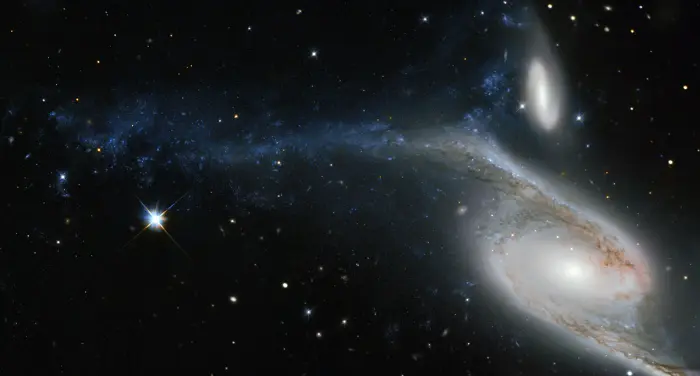
This picture, taken by the NASA/ESA Hubble Space Telescope’s Wide Field Planetary Camera 2 (WFPC2), shows a galaxy known as NGC 6872 in the constellation of Pavo (the Peacock). Its unusual shape is caused by its interactions with the smaller galaxy that can be seen just above NGC 6872, called IC 4970. From tip to tip, NGC 6872 measures over 500 000 light-years across, making it the second largest spiral galaxy discovered to date. In terms of size it is beaten only by NGC 262, a galaxy that measures a mind-boggling 1.3 million light-years in diameter! To put that into perspective, our own galaxy, the Milky Way, measures between 100 000 and 120 000 light-years across, making NGC 6872 about five times its size. The upper left spiral arm of NGC 6872 is visibly distorted and is populated by star-forming regions, which appear blue on this image. This may have been be caused by IC 4970 recently passing through this arm — although here, recent means 130 million years ago! Astronomers have noted that NGC 6872 seems to be relatively sparse in terms of free hydrogen, which is the basis material for new stars, meaning that if it weren’t for its interactions with IC 4970, NGC 6872 might not have been able to produce new bursts of star formation. Image credit: ESA/Hubble & NASA, Acknowledgement: Judy Schmidt (geckzilla.com) (CC BY 4.0)
NGC 6872 and IC 4970
NGC 6872 and IC 4970 are separated by less than 2 arcminutes in the sky. They lie at the same distance from the Sun and are known to be physically interacting.
The smaller IC 4970 is less than one twelfth the size of its larger neighbour. It is classified as a lenticular galaxy of type SA0^- pec. The galaxy has an apparent magnitude of 13.06 and an apparent size of 0.7 by 0.2 arcminutes. It appears 1.1 arcminutes north of NGC 6872.
The galaxies are part of the Pavo galaxy group. The giant elliptical galaxy NGC 6876, the brightest member of the group, appears about 8 arcminutes southeast of NGC 6872. It has a visual magnitude of 10.7 and is believed to contain a binary black hole.
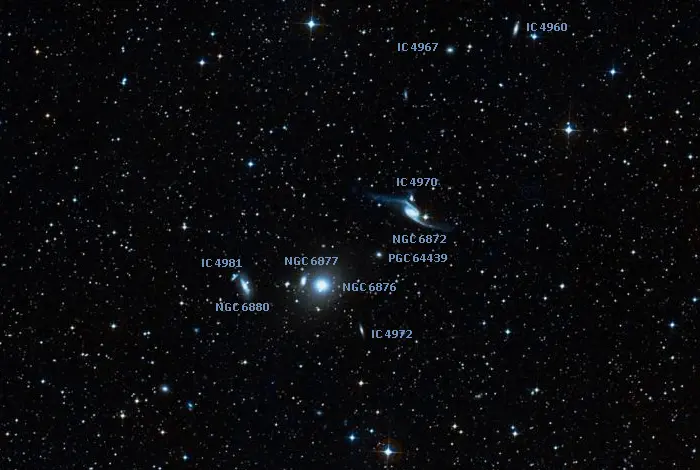
Pavo galaxy group, image: Wikisky
Facts
The Condor Galaxy was discovered by English astronomer John Herschel, who observed it from South Africa on June 27, 1835. Herschel discovered the elliptical galaxy NGC 6876 on the same day. The smaller IC 4970 was discovered by American astronomer DeLisle Stewart from Arequipa, Peru, on September 21, 1900.
IC 4970 contains an active galactic nucleus (AGN), but the nucleus is clouded by dust and gas and can only be seen in X-rays and infrared light. The galaxy’s black hole is likely fuelled by the gas accreted from the larger galaxy, NGC 6872, as IC 4970 is not believed to have a sufficient supply of hot gas to fuel the central supermassive black hole.
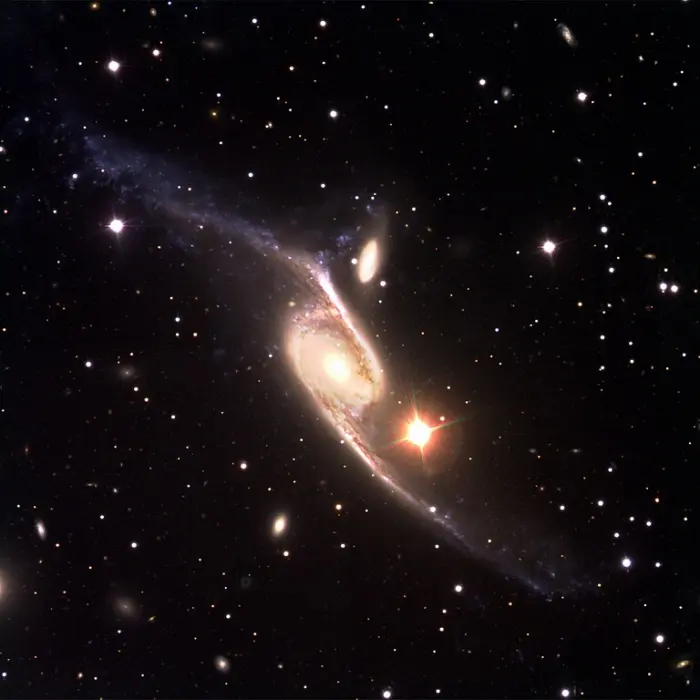
This image is a three-colour composite, this time reproduced from one blue (B), one green-yellow (V) and one red (R) exposure, obtained with the FORS1 instrument on the UT1/Antu telescope in the morning of March 29, 1999. The field size is again 6.8×6.8 arcmin 2. It shows the spectacular barred spiral galaxy NGC 6872 that is shaped like an “integral sign”. It is of type SBb and is accompanied by a smaller, interacting galaxy, IC 4970 of type S0 (just above the centre). The bright object to the lower right of the galaxies is a star in the Milky Way whose image has been strongly overexposed and exhibits multiple optical reflections in the telescope and instrument. There are also many other, fainter and more distant galaxies of many different forms in the field. The upper left spiral arm of NGC 6872 is significantly disturbed and is populated by a plethora of blueish objects, many of which are star-forming regions. This may have been be caused by a recent passage of IC 4970 through it. This interesting system is located in the southern constellation Pavo (the Peacock). It extends over more than 7 arcmin in the sky and its real size from tip to tip is thus nearly 750,000 light-years. It is in fact one of the largest known barred spiral galaxies. In order to image all of this extraordinary object within the available field of the FORS1 camera, the instrument was rotated so that the galaxy extends along the diagonal. For this reason, the orientation is such that North is to the upper right and East is to the upper left. Image credit: ESO (CC BY 4.0)
Location
The Condor Galaxy lies in the constellation Pavo. It appears roughly halfway between Hadar (Beta Centauri) and Tiaki (Beta Gruis), about a third of the way from Epsilon to Beta Pavonis.
At declination -70° 46’, the galaxy is largely invisible to observers in the mid-northern latitudes and is best seen from the southern hemisphere. It can be seen from locations south of the latitude 30° N, but it never rises very high above the horizon for observers in the northern equatorial latitudes.
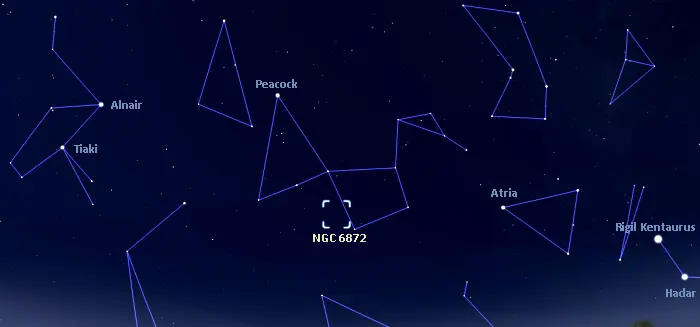
The location of the Condor Galaxy (NGC 6872), image: Stellarium
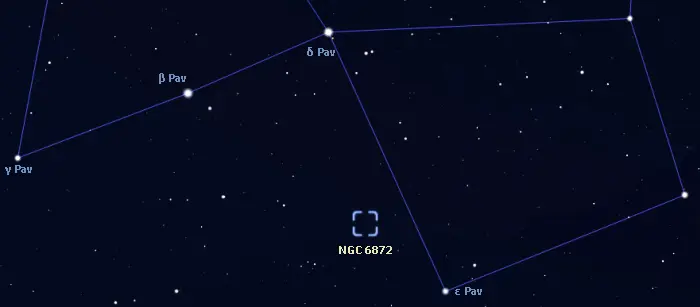
NGC 6872 location, image: Stellarium
The best time of the year to observe the Condor Galaxy and other deep sky objects in Pavo is during the month of August, when the constellation climbs high above the horizon in the evening.
Condor Galaxy – NGC 6872
| Constellation | Pavo |
| Right ascension | 20h 16m 56.4025198800s |
| Declination | −70° 46′ 05.070595584″ |
| Type | SB(s)b pec |
| Apparent magnitude | 10.69 |
| Apparent size | 6.0′ × 1.7′ |
| Distance | 212 million light-years (65 megaparsecs) |
| Absolute magnitude | -23.29 |
| Redshift | 0.015194 ± 0.0001 |
| Helio radial velocity | 4,555 ± 30 km/s |
| Galactocentric velocity | 4,443 ± 30 km/s |
| Size | 522,000 light-years (160,000 parsecs) – UV light diameter 717,000 light-years (220,000 parsecs) – 25.5 mag/arcsec−2 B-band isophote |
| Names and designations | Condor Galaxy, NGC 6872, LEDA 64413, ESO 73-32, 2MASX J20165648-7046057, JB a 28-1, 2E 2011.7-7055, AM 2011-705 |
IC 4970
| Constellation | Pavo |
| Right ascension | 20h 16m 57.35s |
| Declination | −70° 44′ 59.1″ |
| Type | SA0^- pec: |
| Apparent magnitude | 13.06 ± 0.09 |
| Absolute magnitude | −21.00 ± 0.51 |
| Apparent size | 0.7′× 0.2′ |
| Distance | 212 million light-years (65 megaparsecs) |
| Redshift | 0.015728 ± 0.000147 |
| Helio radial velocity | 4,715 ± 44 km/s |
| Galactocentric velocity | 4,603 ± 44 km/s |
| Names and designations | IC 4970, LEDA 64415, ESO 73-33, 2XMM J201657.3-704459, JB a 28-2 |